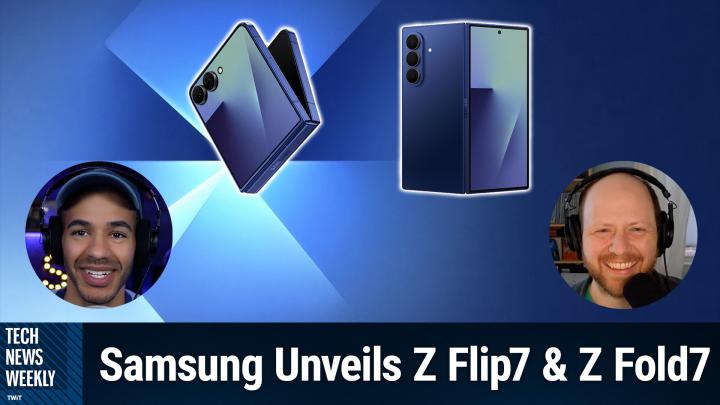The Devices Unveiled at Samsung Galaxy Unpacked July 2025
AI-created, human-reviewed.
Samsung's Galaxy Unpacked event for 2025 delivered a comprehensive refresh of the company's foldable phone and smartwatch lineup, with artificial intelligence taking center stage alongside hardware improvements. The event showcased Samsung's commitment to making foldable devices more mainstream while pushing the boundaries of what smartwatches can measure.
Galaxy Z Fold 7: Thinner Design Comes at a Cost
The Galaxy Z Fold 7 represents Samsung's most significant design evolution yet, measuring just 8.9 millimeters when folded and weighing 215 grams. This engineering achievement comes with a notable trade-off: the removal of S Pen support. As Tech News Weekly host Mikah Sargent explained, "part of the reason the new foldable is so slim is that the company was free to remove that digitizer that was needed to process stylus inputs."
The device features a titanium frame with Samsung's new flex hinge technology, designed to improve durability and reduce the visibility of the crease that has long plagued foldable displays. The internal display has grown to eight inches, powered by Qualcomm's Snapdragon 8 Elite chip and supported by a larger battery. Samsung has also upgraded the camera system with a 200-megapixel main sensor and moved the selfie cameras out from under the display for better image quality.
Starting at $2,000, the Galaxy Z Fold 7 ships with Android 16 and represents Samsung's vision of a premium foldable that prioritizes portability over stylus functionality.
Galaxy Z Flip 7: Bigger Inside, Brighter Outside
The Galaxy Z Flip 7 focuses on display improvements, featuring a flex window that now stretches edge-to-edge with thinner bezels and peak brightness reaching 2,600 nits. The internal screen measures 6.9 inches and offers improved water resistance, addressing one of the key durability concerns with foldable devices.
Samsung has equipped the device with a 50-megapixel main camera and 10-bit HDR processing, while Galaxy AI features include the Now Bar and Now Brief for contextual information delivery. At $1,100, the Z Flip 7 positions itself as the more accessible premium foldable option.
Galaxy Z Flip 7 FE: Foldables for Everyone
Perhaps the most significant announcement for mainstream adoption is the Galaxy Z Flip 7 FE, which Sargent described as "a foldable for the rest of us." Priced at $900, this budget-friendly option features Samsung's Exynos 2400 chip, a smaller battery, and reduced display features while maintaining core Galaxy AI functionality through Gemini integration.
The device is available only in white or black, reflecting the cost-cutting measures that make the $900 price point possible. This represents Samsung's most aggressive push to democratize foldable technology.
Galaxy Watch 8: The Antioxidant Question
Samsung's smartwatch lineup received updates with the Galaxy Watch 8 and Watch 8 Classic, featuring thinner designs, brighter AMOLED displays with 3,000 nits of brightness, and larger batteries. However, the most controversial addition is the antioxidant measurement feature, which uses the watch's sensors pressed against the user's thumb to allegedly provide insights into antioxidant needs.
Tech News Weekly co-host Dan Moren expressed skepticism about this feature, asking "how many people are going to take their watch off every day to check the antioxidants by putting the thumb against it?" His concern reflects broader questions about the reliability and utility of increasingly exotic health sensors in consumer devices.
The Watch 8 Classic brings back the rotating bezel, available exclusively in a 46-millimeter size, appealing to users who prefer tactile navigation methods.
The Foldable Phone Debate Continues
The podcast hosts offered candid perspectives on the current state of foldable technology. Moren acknowledged the appeal of book-style foldables for media consumption, noting "sometimes you might want something that has a larger screen, like, oh, you know what? I'm watching video, I'm on the plane. Isn't it cool that I can flip this open and watch on a larger screen."
However, both hosts expressed reservations about the practical benefits. Sargent pointed out durability concerns, questioning whether the potential for display creases and reduced longevity justifies the technology. Moren added that the flip-style phones essentially become "a big, thick wallet you're carrying around with you" when folded.
The discussion highlighted a persistent challenge for foldable phones: proving their utility beyond the novelty factor while addressing real-world concerns about durability and bulk.
AI Integration and Future Outlook
Throughout the event, Samsung emphasized how AI is reshaping device interaction rather than focusing solely on hardware specifications. The integration of Gemini AI across the foldable lineup demonstrates Samsung's commitment to software-driven differentiation in an increasingly mature hardware market.
The Galaxy Unpacked 2025 event signals Samsung's continued investment in foldable technology while acknowledging market realities through more affordable options like the Z Flip 7 FE. Whether these devices can convince mainstream consumers to embrace foldable technology remains to be seen, but Samsung's comprehensive approach suggests confidence in the category's long-term potential.
As the foldable market evolves, Samsung's 2025 lineup represents both the possibilities and limitations of current technology, offering consumers more choices while still grappling with fundamental questions about form factor utility and long-term durability.
